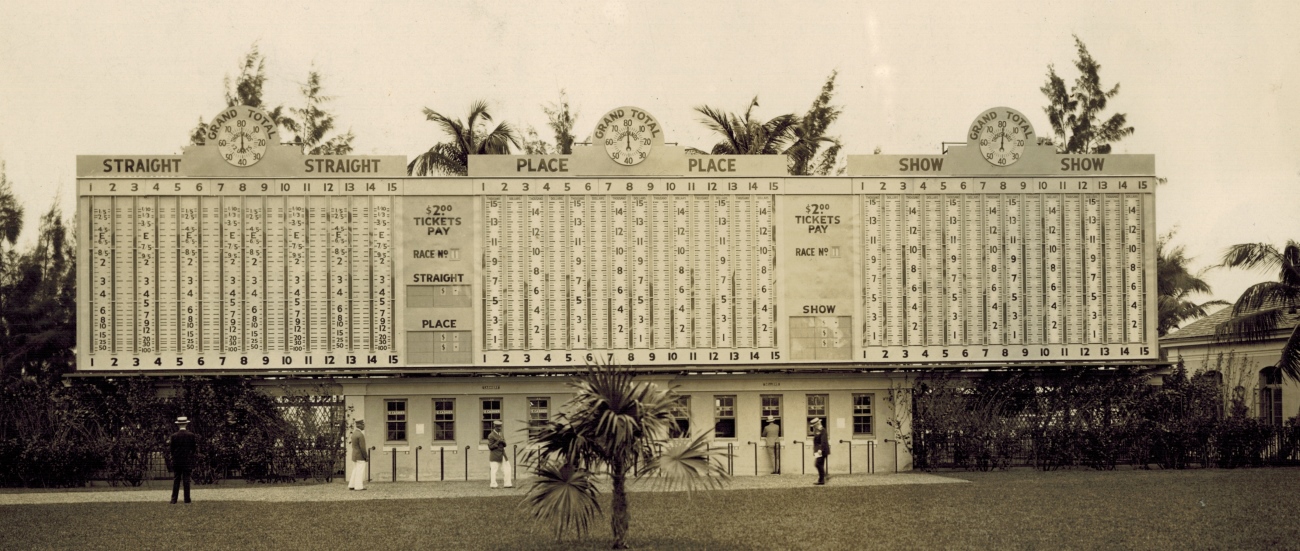
This is one of several history only, non commercial pages relating to the history of the automatic totalizator, its invention in 1913, the inventor George Julius and the Australian company he founded in 1917 which became a monopoly (later part of an oligopoly) in this field. This page relates some history of the American division.
| Americian Division ATUSA |
I received email from Kentucky requesting information on the implementation of early totalizator equipment in America. The business in North America warranted the establishment of a subsidiary company which was called Atusa which is a mnemonic for Automatic Totalisators USA. Atusa then became ATI - Automatic Totalisators Inc. and in 1978 changed its name to Autotote, the name by which it had become well known throughout the racing and wagering industry in its home market. Autotote was renamed Scientific Games. As of 2013, it is owned by Sportech Inc. I have acquired the following information.
| Hialeah Park's Australian totalizator |
Following is an article from The Herald Miami Florida from The Sport Desk by Jack Bell 1932 Titled Hialeah Park's Australian totalizator.
Reprinted with the permission of The Miami Herald.
I'm going to try and tell you a bit about the strangest machine it has been my pleasure to see- The Australian totalizator , to be used in Hialeah Park mutuel plant the coming meeting.
Here is a machine which takes your money, dumps it out the pot records the new total all over the plant, figures up the odds-then prints your ticket and hands it to you. And they tell me the machines will knock off tickets at the rate of 120 per minute.
the Australian machines, never in use in America before, are designed chiefly for the purpose of preventing mistakes and for the swift and accurate computation of the mutuel odds. Old-time horsemen around the track will tell you the " damned thing will never work " in no uncertain terms. They see all the mechanism and shake their heads doubtfully
But L.L. Raymond, manager of the company which manufactures the machines in Sydney, Australia, simply smiles and goes on with the work. He has several assistants here from Australia and they're just about ready to start their machines in operation. In fact, great units of the mechanical device are in operation now.
Now, I'm no mathematician ( thank God ) and can't tell you all about the workings of this machine. But it is one of the most interesting features of Hialeah Park and I'll do my best. Perhaps, if a mathematician explained it, nobody but another expert on figures would know what he was talking about, anyway.
In the first place, you should know that you don't get your ticket until your two bucks are checked into the unit, figured into the pool on your horse and into the total pool on the race-in case of win pools. In place and show pools, of course, the machines can only show the total amounts bet on each horse, until the three money horses are under the wire.
When you place a bet you must do so by number. That is, instead of betting on Twenty Grand, you take his number (say it's 4), go to the window and ask for a " ticket on No. 4." The man at the machine has three loops on his instrument-- win, place and show. If you want a win ticket he presses the point of a little lever into the No. 4 hole in his win numbers. This immediately completes a circuit which automatically adds a $2 bet to the total for that horse and flashes the additional money on over to the win pool on the race.
This operation then releases the little printing device in the machine at the window and your ticket is printed and flipped out to you.
When the windows open there isn't a printed ticket in the plant. Each machine is threaded with a roll of blank paper. When you make a bet and the operator presses his lever point the machine pulls the strip of paper over the printing device, stamps it with the number of your horse, the number of the race and the amount wagered.
This you see, eliminates printing thousands of extra tickets each day, enables the operators to throw open their windows immediately after the race, ready for the next race. And of course the use of the totalizator gives the bettors the chance to place their money right up to the minute the horses are ready to leave the post.
The mutuel machines are controlled from the stewards stand, as the horses go to the post. When the starter gets them lined up and the steward thinks it is time to stop the mutuel wagering on the race, he presses a button.
Thus, the steward stops every mutuel machine in the park. No more tickets can be sold because none can be printed. And the odds do not need to be figured because they are kept right at the actual percentages throughout the betting period of the race.
All this sounds like a heluva a lot of mechanism, doesn't it. Well, it is. That's why the old-timers have joined the anvil chorus; they can't see how all those little gee-gaws and do-dads will ever keep going. We did a lot of wholesale figuring and found that by counting every bit of wire running from the machines to the various boards and other places, we have 195 miles- yessir, 195 miles of wire- running around in the form of cables and whatnot.
They've most of the units running now. They run several hours daily to get "broken in," as we do with the automobiles. At least, we once did new automobiles that way; it has been so long since I saw a new one I don't know what they do with 'em now. But this Australian totalizator never will be as common as the automobile; they do say the whole system has cost Mr. Widener $350,000 which sum, even to Mr. Widener is important money.
You're going to think you're in a weather bureau plant for a few days. The odds on each horse are shown by a device which operates just like huge thermometers. In the win pool ,which will be opposite the grandstand, in the infield, each horse will be represented by a "thermometer". Various odds will be listed on the board and as the money is wagered and recorded on the machines, the mercury columns on the board will rise and fall just as they do on a thermometer - only much faster.
Indicator and tote at Hialeah

Mr. Raymond and his organization seemingly have overlooked nothing in the construction of this marvelous machine. When the money flows in there is a small machine--a unit, as they call it--which collects for each horse in the race. I mean, darn it, there are three such machines for each horse--a win, a place and a show unit. But all the win units are in one group, the place and show units in two others.
Each "horse unit" (let's say we are talking of the win bets now) sends its bets into a larger computation machine as they come in. This machine continuously adds the money, sends the totals along to still another unit, which deducts 10 per cent for "the grand and glorious state of Florida (and may our taxes decrease!)," and the remaining 90 percent goes on to the machines which show the odds on the big board on the infield. These constantly changing odds, as indicated by the barometric readings on the board, are computed by use of a system of angles too complicated for me-and you, too. But it works.
"What if the Florida Power and Light fails?" I ask Mr. Raymond, thinking to find out about many of the objections I hear.
"We've a big dynamo of our own," he replied, "which can be turned on automatically and will operate the machines within 30 seconds after the local power fails."
"What if both power plants fail?"
"We've the usual mutuel system in the plant, ready to use in case of such an emergency. That's in our contract with Mr. Widener. He insisted on it."
" What about large amounts of money? People tell me that if the handle is large machines won't take care of the bets."
" These machines are set to handle $400,000 on each race. And they'll do better than that. If necessary we could set them to handle more. But I don't think you'll get more than that--do you?"
" No," sezzi, a bit dizzy, "I don't." These fellows who talk complacently of such huge figures bother me.
" We handled a million bets one day in Paris," he went on, "and never had a bit of trouble. We've 44 plants in operation in England, France, India, New Zealand and Australia. We're going to Brazil soon to install one there."
They seem perfectly certain that nothing can happen to these machines. Mr. Raymond showed me the operation of a machine, which was uncovered for such demonstration. The tickets are printed on a paper which comes in a roll and is used as the tickets are printed, clipped off and tossed out to the customer.
There will be about 65 machines, if I remember correctly. The greater number will sell $2 tickets, of course, but there will be $5, $10 and $50 machines. The belief all over town that this system will eliminate workmen at the selling windows is not true. Each machine must have an operator. The system merely prevents the operator from getting his tickets mixed up and making other mistakes.
Mr. Raymond says the machine will print 120 tickets a minute if necessary. This will speak in defence of the tales around town to the effect that if a man wants to bet $1,000 the last minute, that he can't get all his money down. The machine operator doesn't need to punch his lever point for every ticket. If he wants to run off 20 tickets of $50 each he merely holds the point down until the machine clicks off the required number--something like the way we used to hold that button on the old Vickers machine gun when le Boche got too pestiferous.
If only you could get your hawss home as easily as you get down a bet on him--!
The Hialeah Miami Julius tote Show Pool 1932
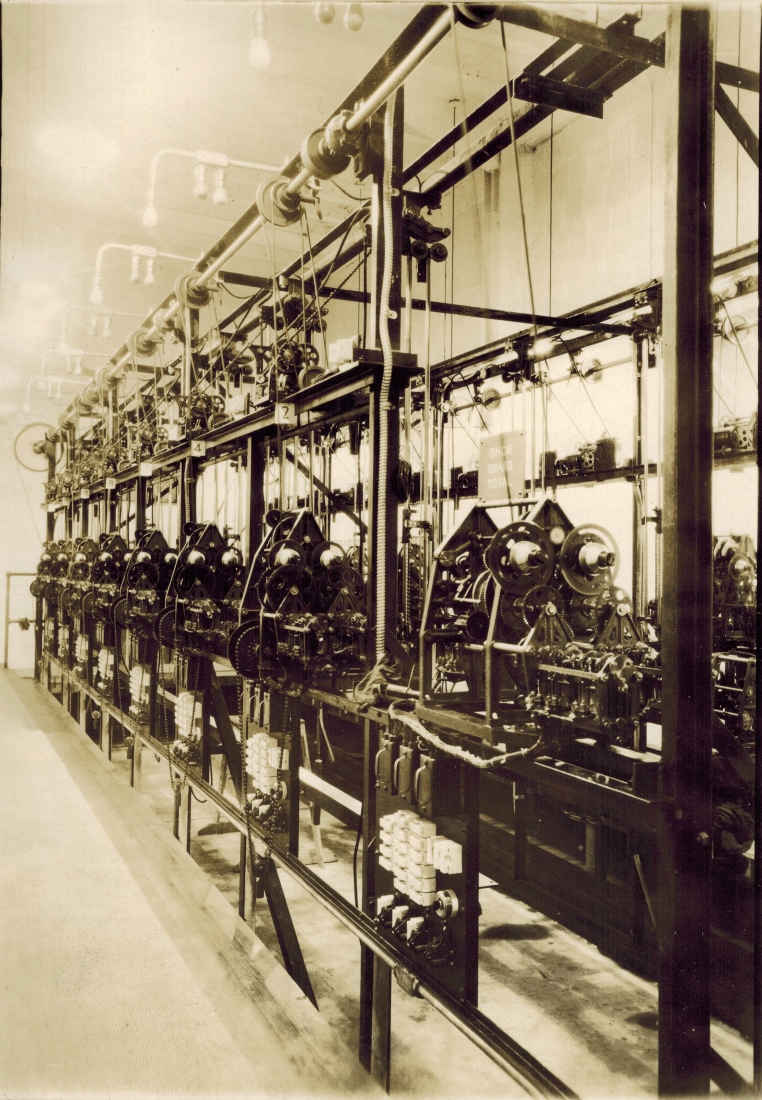 Photo by Ray B. Dame
Photo by Ray B. Dame
The above photo shows the part of this Julius tote system that is handling the Show pool. Other frames like this one will be handling the Straight and Place pools. Apart from handling the betting the system in the photo will also be driving the Show Pool section of the indicator in the first photo on this page. In the image above there is a sign on top of the nearest adder. It reads Show Grand Total. This adder records the Show pool grand total investment. All the other adders total the investments on their associated runners. The runner numbers appear on top of every adder and the odd number runner adders are on the rear side of this frame. The commissions are subtracted from the grand total figure calculated by the GT adder and the resulting net pool grand total becomes part of the system's calculation of the odds shown on the indicator in the first photo. This Net Pool Grand Total is also displayed on the Grand Total indicator on top of the runner odds in the first photo.
There is a video clip titled "Opening Day Hialeah Park 1932" in the eighth video clip in the Video Clips chapter of this website, which has short segments showing the system in the above images operating.
There are images of the Hialeah Park Julius Tote installation equipment along with additional information, in the second page of the Photo Gallery in this website, under the heading Hialeah racetrack in Miami 1932. There are enlarged versions of the two images above included in those images. Click on the image thumbnails to load the full sized images in the Hialeah section of the index section of the second page of the Photo Gallery.
| Automatic Totalisators Limited 1977 Report to Employees |
| North American division |
The North American division has enjoyed significant growth again this year. During this period of increasing sales and leasing volume, emphasis on cost controls and operating efficiencies was maintained. North American sales increased by approximately 47% for the year, and after tax profits increased by approximately 73%. The North American Division contributed approximately 80% of group profits.
TOTALISATOR OPERATIONS continue to expand with seven computerised totalizator systems placed into service in New Jersey, New York, Ohio, Connecticut, Puerto Rico, Maryland and Kentucky during the year.
Included in this group of new installations is the Meadowlands race track operated by the New Jersey Sports and Exposition Authority which started operating on September 1, 1976. The Meadowlands ran 181 days of harness racing this year and is scheduled to run 100 days of thoroughbred racing starting later in 1977. It has exceeded all forecasts for attendance and has quickly become one of the largest money handling race tracks in the world. Also included in these new operations is the new Milford Jai Alai in Connecticut. This Jai Alai - as is the case with the Hartford Jai Alai and the Bridgeport Jai Alai at which your Company opened in May and June 1976 respectively - have exceeded original forecasts and have each been averaging in excess of $US500,000 per day totalizator turnover.
In addition to the above openings, contracts have been received during the year for a total of nine lease, operating, sales or service agreements, three of which have opened during the year. The six others are scheduled to open in fiscal 1978.
Activities have been accelerated in both South America and Europe. Representatives have been selected in Mexico, Venezuela, the Dominican Republic, Peru, Brazil and Colombia and a contract has been obtained for a PDP-11/J17-3 totalizator system for a new race track being built near Bogota, Colombia. This approximately $US 1.5 million system is scheduled to be shipped in late 1977.
A number of other significant negotiations are currently in progress in this territory.
In Europe, headquarters located in Konstanz, West Germany, have been established by the North American Division. From this office, potential business is being actively pursued for on track, off track and on line lottery system contracts in Germany, Sweden, Finland, Belgium, England, Italy, Greece and the Netherlands. Management is optimistic that within the next few years this significant effort aimed at developing business in this market will be fruitful.
NEW MARKET DEVELOPMENT activities have been accelerated in the areas of lotteries, off track betting and parking systems.
Two new lottery contracts have been obtained. One is for the implementation of a manual system in the State of New Hampshire which went into operation in March of this year. The other is for a prototype system designed to put the Massachusetts State Lottery customer-marked betting slip system, a part of which we provided in 1976, on line in real time. The Research and Development group in the United States have developed the J25 terminal in response to this contract. A prototype Terminal was delivered to Massachusetts in September 1977, the balance of the prototypes are scheduled for delivery to Massachusetts in October. Initial reaction of Massachusetts State Lottery officials has been very favourable. We feel that the J25 terminal responds to both lottery and off-track betting needs for a fast reliable terminal capable of handling keyboard input simultaneously for both selling and cashing functions in a real time, on line mode. If this prototype installation is successful, it is expected that significant new orders for on line lottery terminals and systems will result. Inquiries have already been received for the J25 terminals from other lotteries and off track betting applications in the United States, Europe and South America.
The Parking System Division successfully installed a Parcotax revenue control system at the new Philadelphia International Airport garages and it has been operating to our customers satisfaction ever since. A new contract has been obtained from Kinney System Inc. for the Philadelphia Market Street East parking garage and successfully installed at that location. A contract has also been received from the City of Cedar Rapids, lowa, for a parking system for a large hotel and shopping complex parking area. The system includes both automated, self service pre cashiering stations and Dectocard monthly contract parking revenue control as well as entrance and exit traffic control equipment.
Sales activities aimed at expansion of the Parking Systems Division penetration of North American markets are actively being pursued. Negotiations are currently under way for revenue control installations at parking facilities in a number of major airports and municipal parking garages in the United States and Canada.
Trends in our basic on track wagering systems industry continue upward. Lotteries and off track betting markets are expected to yield significant business for your Company during the next several years. Toward this end, emphasis continues on the development of on line sell/pay terminals by the totalizator Division in Sydney combined with the Research and Development activities in the United States aimed at North American Division markets.
The parking systems business, while still in its infancy shows considerable promise. Further opportunities for intelligent diversification are expected to materialise in the near future. These will be pursued with the view to further broaden our base of operations and to enhance our ability to produce secure and increasing profitability.
| ATL international name in totalizator betting systems. |
This is an extract from a company booklet with the above name. Note - In the interests of political correctness, I have removed the names of the countries whose export trade are compared to the totalizator turnover.
It is interesting to note that this system is one of the world's early examples of continuous processing computer architecture. This architecture was applied to all the computer tote systems produced by Automatic Totalisators. The NYRA tote system was a triplex system with a throughput of 1,200 transactions per second. It has been my experience that punters, as with most human beings, are not patient when it comes to money matters and the tote is all about money. If the perceived performance of the tote machinery does not match the expected performance then things are likely to get ugly rather quickly. The predominant expectation in this case is perfect operation all the time.
What makes Aqueduct one of the great racecourses of the world? Horses like Damascus who raced 10 furlongs there in 1.59 1/5 seconds and people, like the crowd of 73,435 who spent over six million at a single meeting at "Big A" on a big betting day in May 1965. Horses and people who create these records make a racecourse great by any standards.
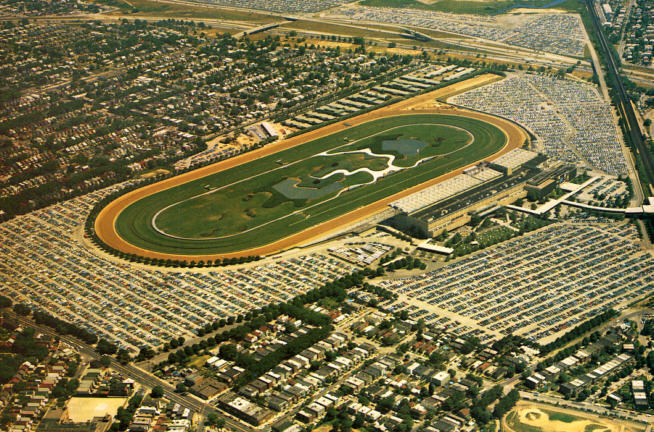
Aqueduct and its sister courses, Belmont Park and Saratoga, controlled by the New York Racing Association, ( N.Y.R.A. ), in a single season cater for an attendance equal to the total population of Australia. Their combined totalizator turnover in a single season - seven hundred million dollars - exceeds the total annual export trade of ... or .... When N.Y.R.A. decided to install the world's first Electronic totalizator System to handle its enormous turnover of people and money, it selected ATL to do the job. The Aqueduct equipment is portable and is also used at Belmont Park and Saratoga. The outstanding thing about the equipment which serves all three courses is its durability... it operates on huge turnover figures on 234 race days each year!
The Aqueduct Computer Room
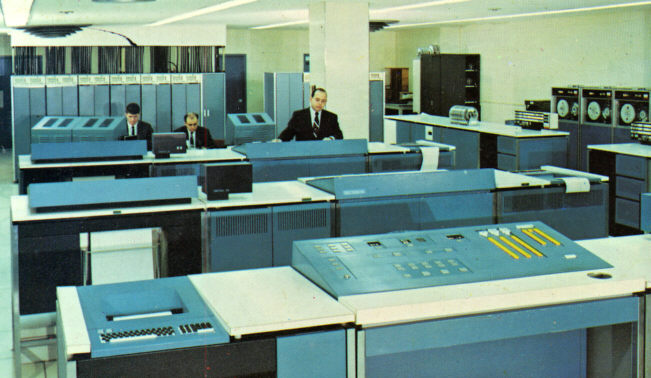
Smaller general purpose computers with most of the features of the Aqueduct system now serve a growing number of racecourses in other parts of the world.
Following is a small segment from a company document called The Computer Tote
In 1966 Automatic Totlisators Limited took the racing industry into the electronic era with the development of the world's first Computer Tote System, for the New York Racing Association, which handles a totalisator turnover each season of over $700 million. The New York Racing Association, which controls the world famous Aqueduct, Belmont Park and Saratoga racecourses, chose A.T.L. to make this unique computer tote installation because of the long experience, extensive research and continuing service maintenance which the Company offered along with the product.
The system offered to the NYRA was, of course, designed by ATL engineers in considerable detail before the submission of a proposal. However with a project of this magnitude, many months of study and research were necessary before an overall system specification could be finalised. Engineers and programmers had to spend weeks at Racecourses, recording all operations, studying figures and interviewing tote personnel. Finally a system emerged that catered for all contingencies. It, incidentally, offered additional features which even today, are unmatched elsewhere.
Development of the system and construction of the equipment required the whole hearted co-operation of the two sub-contractors Honeywell Ltd. and Data Trends Inc., with ATL as the prime contractor. Honeywell supplied the computers and peripheral equipment and Data Trends supplied the interface equipment and the program.
The development was matched to a very tight schedule. The most immediate goal being an on-line test for 20 days at Saratoga in August 1965. A development centre was established on the premises of Data Trends Inc., at Whippany, New Jersey in late 1964. To this site Honeywell delivered two H200 Series computers the "Brains" of the system. As each company completed various phases, they were all married together at Whippany to build up the complete system.
For instance, when the first four J11 TIMs arrived from Australia they were tested with the scanner from D.T.I. When the TIM service section of the computer program was finished it was possible to bet from the J11 through the scanner to the computer.
Every two weeks a progress report was made to the customer and every month a demonstration of progress to date was shown. The overall progress was very closely scrutinised and checked against the time chart, firstly by A.T.L. as prime contractors and secondly by Arthur Young & Co. business consultant, appointed "Watchdogs" by the customer.
By May 1965 the system was approaching completion. J11 TIMs were arriving from the factory at Meadowbank which was striving hard to complete the order of 550 on time. Wilmington office was working at top gear, producing cable racks, indicator board and counter cubicles, buying cables and lamp-boxes and tuning TIMs.
...
Upwards of 100 people were employed on site during the installation period and at this time maintenance personnel were hired and trained. Four American engineers were engaged for central computer control, and their training included, computer programming, fault analysis, maintenance procedures and lectures on that intangible quality known as "Tote know-how". Eighteen Union electricians were screened and hired for raceday selling line control and TIM and Indicator Board maintenance. Selected men were also trained in the maintenance and operation of the standby power equipment.
...
One month prior to opening, a full scale test was held which included the introduction of 300 sellers to the new TIM. This test, like previous tests, was controlled by the New York Tax Commission. This Commission is the Government's agent for ensuring firstly, that the Government revenue from racing is assured under the new system and secondly that the racing public interests are protected. Under New York State Law, should racing be suspended due to failure of the totalisator the Government must be reimbursed for lack of revenue. Failure at this juncture would have been a catastrophe but fortunately all went well.
...
The great day finally arrived, March 14, 1966. Promptly on time the START BETTING button was pressed by Mr. A.A. Boa and the NYRA Computer Totalisator sprang into action, accepting bets from the public faster than ever before. ATL equipment and competence were on show to the racing world. Hundreds of racing officials, newsmen and Government dignitaries were given demonstrations of the new system.
The complex of new equipment far exceeded expectations. Racing officials were amazed at the speed, and accuracy of the system. All the New York daily papers ran features on the new system and headlines read "Automation comes to the Big A", "Racing goes Electronic" etc.
To read about the J11 TIMs at Aqueduct have a look at this J11 image and associated text in the Photo Gallery.
Two hundred miles north of New York City, Saratoga is in the Summer resort area of the Adirondach Mountains. The town is virtually closed during the winter months, the main industry during this time being Skidmore College, one of the largest girls' colleges in the U.S.A. During the summer the population increases ten fold, with everyone escaping from the heat in New York.
The Saratoga slogan is Health, History and Horses. The Health comes from the multitude of mineral baths and springs which attract mostly the aged and infirm. The area abounds in History as, in this region, many battles were fought in the English-French wars. At the turn of the century Saratoga was renowned for its gambling. It was the forerunner of the present day Las Vegas. Some huge decayed Casinos and Hotels still dot the area, several being turned into Museums.
Saratoga Racetrack is one of the oldest existing race courses in the U.S.A. Racing began in 1863 at the present site. Large extensions have, of course, been made since but all additions have been designed to blend in with the old stand which still exists.
Although Saratoga races only 24 days a year, August, and handles about one third the turnover of Aqueduct it is a most welcome excursion each year for all the racing fraternity. Unlike Aqueduct, racing at Saratoga has a picnic air about it, the grounds being covered with green lawns, gardens and trees.
Belmont Park is situated ten miles further out on Long Island than Aqueduct. The old track was dismantled in 1964 and is at present being rebuilt at a cost of approximately $40 Million. It is expected to be completed by early 1968 and will be one of the most modern and beautiful racetracks in the world.
Chris Robertson's Belmont Tickets
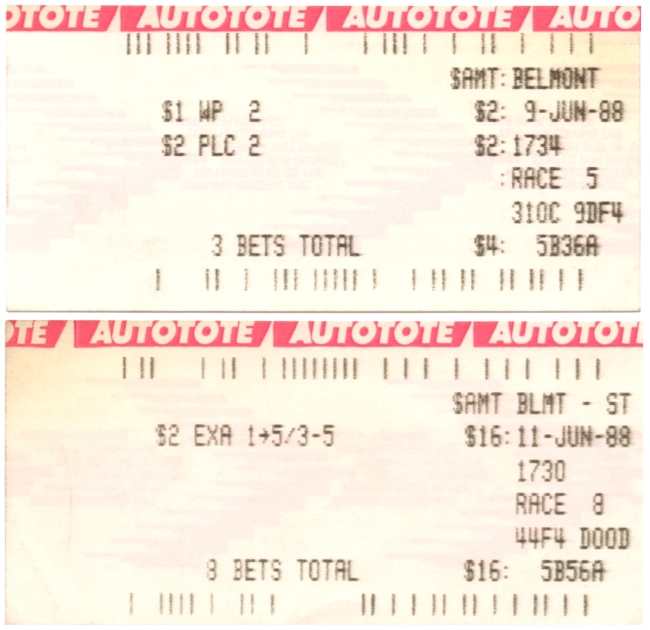
Chris Robertson, an ex high value punter with an amazing knowledge of totalisator history provided the above images of Belmont tickets from his global collection of tote tickets. If the rebuilt Belmont Park track was completed in 1968 as expected according to the above article, then Chris purchased these tickets 20 years later. Autotote had a self serve terminal called a (SAM) or Screen Activated Machine, which accepted a voucher for payment, which could be produced by any other terminal on the track. Chris wrote the following comments about the SAM and the second ticket of the two tickets above:
Regarding Autotote's Screen Activated Machine brochure the lines to use these terminals were longer than at the regular betting windows, mainly because the SAM would randomly generate free vouchers to lucky bettors for varying amounts. Unfortunately this did lead to bettors splitting their bets over as many tickets as possible to increase their chance of being awarded a free voucher. Stands to reason.Later, after reading more about the NYRA system on this website Chris made the following comment.A feature of both Autotote and Amtote tickets was that instead of listing each number taken, consecutive numbers were connected by an arrow. The second ticket is an exacta with all numbers between 1 and 5 on top, and numbers 3 and 5 on the bottom.
I enjoyed reading the new material on your site, especially about the NYRA computer tote. The TIM of choice there was the J11, just as it was at Sydney's Harold Park and Wentworth Park at roughly the same time. While the J11 was ideally suited to maximum sized fields of twelve, it could easily have been adapted to fields of twenty-four as part of a computer tote at Australian racecourses. The doubles and quinella operations could still have been handled by the J10. In the 1970's there was not a great demand for real time betting approximates on exotic pools, but an accurate display of win and place odds was desperately needed if the tote was to compete on a more even footing with bookmakers.
| New Electronic Totalisator At Georgetown - Tote Topics |
Following is an article from Tote Topics No. 25 January 1969.
On 20th November, 1968, Automatic Totalisators Ltd. pioneered a new phase when an Electronic Totalisator using P.D.P.8 computers made its debut at a harness track in Georgetown, Delaware, U.S.A. This system is the successor to the world's first fully computerised totalisator installed by A.T.L. at Aqueduct for the New York Racing Association in 1966. The success of the N.Y.R.A. system, which uses Honeywell computers, has won world-wide acclaim from all sections in the racing industry.
Experience gained at Aqueduct and advanced computer technology have allowed development of this new electronic totalisator system, which is more suitable for racetracks of average size. The system has all the features of the larger Aqueduct system but is more compact and less expensive. The Georgetown operation is the forerunner of many similar operations in the very near future.
Probably the Georgetown PDP8 tote Computer Room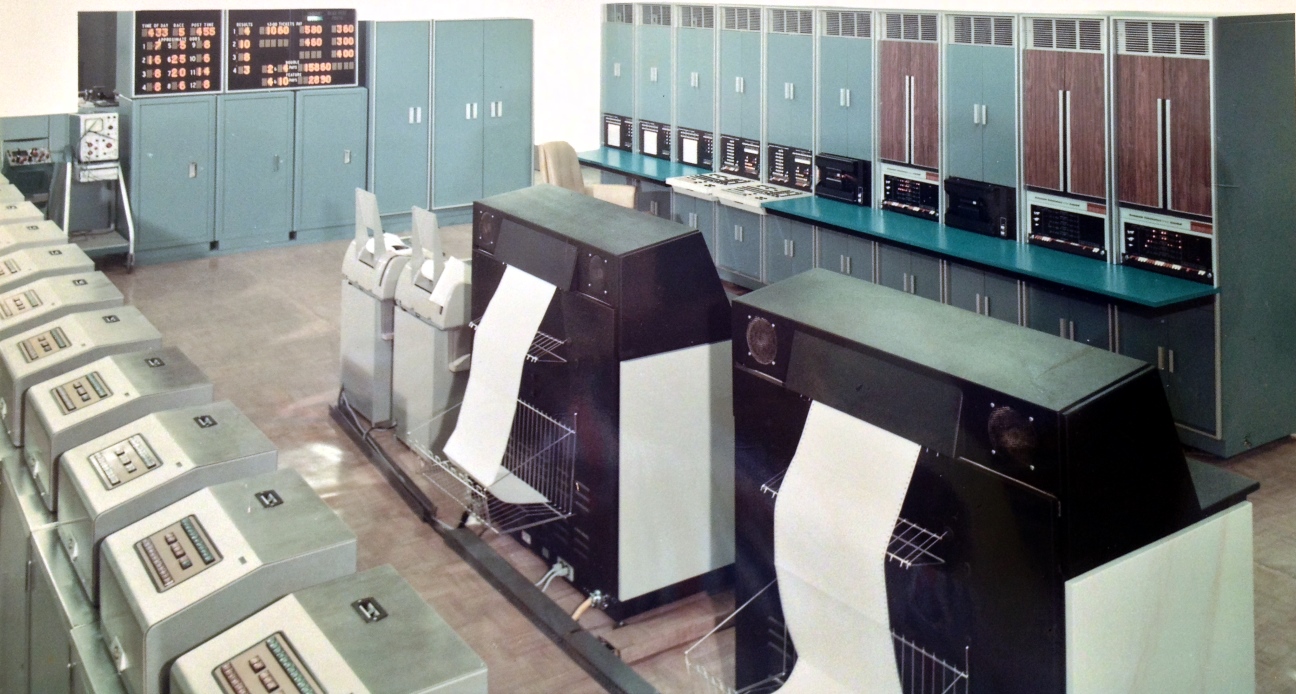
The above image is not part of the Tote Topics article. I have presented it here to provide a view of what is being discussed. This image is definitely of an Automatic Totalisators PDP8 tote system installed in the USA by the American subsidiary and as Georgetown was the first of these, it is probable that this is the Georgetown system. Additionally, note the row of oddly 11, J11 TIMs (Ticket Issuing Machines) across the bottom left corner of the image. This TIM was popular in North America and are mentioned later in this article. The TIMs are probably in the computer room for testing or alignment purposes.
This electronic system was assembled at our Wilmington factory under the supervision of Australian engineers. It is a 12 starter system designed for American operations and embodies full duplex operation with two computers on line at all times. A third computer is incorporated into the equipment as a standby unit.
The complex computer programming was done in the Research Department of our Meadowbank factory in Sydney, where the initial system concept and design evolved, and where the prototype electronic system is situated.
Georgetown, which is a small farming town situated in the lower section of the State of Delaware, was chosen for the pilot installation because of its proximity to the Company's premises in Wilmington. The track is a relatively small trotting track, racing for approximately 70 days (five days per week) throughout the winter months from November to March. The grandstand is completely enclosed and heated, catering for about 5,000 patrons. The track was built in 1965 and originally opened with our standard electromechanical equipment.
A new room was fabricated to house the computer system with associated High Speed Printers and cable racks. A total of 56 Ticket Issuing Machines installed in the original selling houses provide betting facilities at each meeting. The Ticket Issuing Machines are our J11 type, 12 starter, press button machines capable of selling WIN-PLACE-SHOW, DOUBLE and EXACTA and were manufactured in Australia at our Meadowbank factory. A proportion of the selling windows is allocated to WIN-PLACE-SHOW and the remainder sell either DOUBLE or EXACTA, dependent on the racing programme. The system is most flexible and any machine can be changed from one pool to another by inserting an appropriately punched card into a special purpose reader situated in the control room.
The infield display indicator giving odds, dividends and results is constantly monitored by a closed circuit television system. Two auxiliary odds indicators and a computer room monitor complete the display equipment. All indication is lamp box type display incorporating new type lamp boxes with printed circuit card control.
The Judge controls the display of results, time of race and the various signs such as photo, dead-heat, etc., from a console in the Judge's room.
The standby power equipment to provide an uninterrupted service under any conditions is housed in a mobile van positioned outside the grandstand.
Prior to opening, exhaustive tests were carried out on the system to ensure its readiness of operation. All dividend calculations were checked to ensure they complied with the local State Racing rules.
On opening night all nine races were handled without a single error and close to 100 races were run before a system alarm was encountered. The alarm was caused by a visitor bumping a switch! The switch was restored and operation continued without any noticeable delay. The system operation was controlled by two American engineers who were trained in the equipment at our Wilmington plant.
Although the Georgetown turnover is small (average for the previous season was $US 82,000 per night) all facets of the new system were thoroughly proven. While the traditional A.T.L. check on the check is inherent in the system, the manual dividend calculators were retained for several days until the mutuel staff had gained sufficient operational experience.
The opening meeting was attended by members of the Delaware Racing Commission and many other officials from the racing fraternity. All were impressed with our system and the Press gave a favourable coverage of the operation.
The field trial at Georgetown has established beyond doubt that the A.T.L. Electronic Totalisator using P.D.P.8 computers is the most modern totalisator system offering flexibility, accuracy, reliability and economy, available anywhere in the world to-day.
F.G.R.
Since Peter Collier first identified F.G.R. as Peter Rolls, F.G.R.'s tragic obituary has been added to this website in the "3 More ATL systems in Asia/Links to other pages" chapter, which confirms this is the case. To read it, select the "Go to the index" button in the Nav Bar at the bottom of this page and select the chapter mentioned in the "Posthumously" section of the index.
| Quarter Horse Racing Tioga Park - Tote Topics |
Following is an article from Tote Topics Autumn 1977.
July 1, 1976, quarter horses were raced in Nichols, New York for the first time since colonial days. Legalized in New York in 1970, the sports' first pari mutuel racetrack, Tioga Park, is set among the rolling hills of the state's Southern Tier just outside the hamlet of Nichols, between Elmira and Binghamton on the route 17 expressway.
Tioga Park is pioneering in the Northeast bringing a brand new three hundred year old sport to area racing fans. Quarter horse racing, long forgotten on the eastern seaboard, took six years to get there, but Jacob Iberger, Tioga Park President and General Manager thinks it's just the beginning for the sport in the area. ...
The grandstand was constructed to take advantage of the natural terrain of the area and was set into a large bank of earth overlooking the track's racing surface. "That idea came as a result of my year on the road," said Iberger. "I saw this little country dog track up in Belmont, New Hampshire, that was built that way and it seemed like a good idea." It was. It saved a great deal of money and construction time and was one reason the track opened on July 1st this year, only eight months after construction began.
"We planned the track in phases," explained Iberger. "Phase one is now complete and phase two will include a plush dining room on the east end of the grandstand and more seating on the west end."
Right now the track seats between eight and ten thousand. There are mutuel lines along the top and to the rear of the grandstand and trackside as well. Mutuels are handled by 69 ATI J-11's linked to a computer tote, offering Win, Place, Show, Double, Quiniela, Perfecta and Trifecta wagering. "We built to accommodate fast and easy expansion. We can just about double our complement of ticket issuers without doing a lot of extra construction," said Iberger. The physical plant is basically a wood column structure, one reason the construction time was short. There is the grandstand, complete jockey quarters, a saddling area, and an administrative building. Recently complete are an additional two barns adding 132 stalls to the track's opening complement of 803.
Tioga Park Water Tank with horse and rider on top
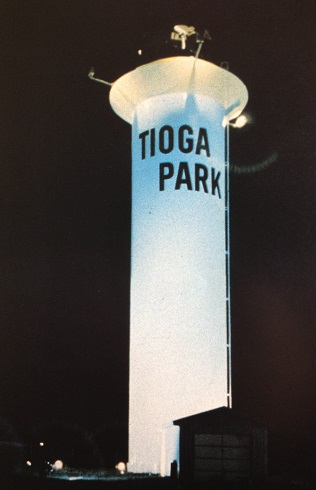
"We also have a great landmark," said Iberger, "you can't drive by here without knowing we're around." The landmark is an 85 foot water tank that looks just like a lighthouse. High atop is perched a huge steel horse and rider that, despite its 1600 pounds, acts as a weather vane.
The track has proved to be a real boon for the town of NIchols. Local contractors were involved in the construction and about 400 of the town's people are now regularly employed at the track. Property values are on the rise, as some of the trainers are buying farms in the area to breed and train quarter horses to meet the demand that Tioga is already generating.
For opening nearly 800 horses were attracted from 22 states to race around the Tioga 5/8th mile oval track. The track's 108 day schedule is the longest continuous quarter horse race meeting in the country and many horses came from as far away as the southwest, the country's center for quarter horse racing. Others came from Virginia, Maryland, and Pennsylvania, including show horses recently turned to racing. ...
This article first appeared in "Quarterly" the house journal of Automatic Totalisators Inc. ATI is a wholly owned subsidiary of Automatic Totalisators Limited.
| United States of America Installations |
The following list are computer tote installations only.
| Aqueduct - New York | Belmont Park - New York | Big Bend Jai Alai - Florida | Calder Race Track - Florida |
| Cranwood Racing Club Inc. - Ohio | Dania Jai Alai - Florida | Daytona Beach Kennel Club - Florida | Detroit Racecourse - Michigan |
| Dover Downs Race Track - Delaware | El Commandante - Puerto Rico | Flagler Kennel Club - Florida | Fort Pierce Jai Alai - Florida |
| Greene County Greyhound Track - Alabama | Gator Downs Race Track | Harrington Raceway - Delaware | Hartford Jai Alai - Connecticut |
| Hollywood Park | Hazel Park | Jackson Trotting Association - Michigan | Jefferson Downs Race Track - Louisiana |
| Lakefront Turf Club Inc. - Louisiana | Lake Region Greyhound Park - New Hampshire | Laurel Raceway - Maryland | Lincoln Greyhound Park - Rhode Island |
| Louisiana Downs - Loisiana | MGM Grand Hotel - Las Vegas, Nevada | MGM Grand Hotel Jai Alai - Reno, Nevada | Miami Jai Alai - Florida |
| Milford Jai Alai - Connecticut | Mobile Greyhound Park - Alabama | Mountainview Thoroughbred Racing Assoc - Penna | Naples-Ft.Myers Kennel Club - Florida |
| Narragansett Park Race Track - Rhode Island | New Hampshire Kennel Club - New Hampshire | N.J. Sports & Exposition Authority - New Jersey | Newport Jai Alai - Rhode Island |
| Northfield Park - Ohio | Ocala Jai Alai - Florida | Orlando Seminole Jai Alai - Florida | Palm Beach Kennel Club - Florida |
| Park Jefferson - South Dakota | Parr Meadows - New York | Penn National Turf Club - Pennsylvania | Pocono Downs Race Track |
| Pompano Park Race Track | Randall Park Race Track - Ohio | Red Mile - Kentucky | Rocky Mountain Kennel Club - Colorado |
| Rosecroft Raceway - Maryland | St. Petersburg Kennel Club - Florida | Sanford Orlando Kennel Club - Florida | Sarasota Kennel Club - Florida |
| Saratoga Harness Racing Inc. - New York | Shamrock Racing Association - Pennsylvania | Sodrac Greyhound Park - South Dakota | Southland Racing Corporation - Arkansas |
| Summit Racing Club Inc. - Ohio | Tampa Jai Alai - Florida | Thistledown Race Track - Ohio | Tioga Park - New York |
| Toledo Maummee Raceway - Ohio | Tropical Park Race Track - Florida | Washington County Kennel Club - Florida | Waterford Park - West Virginia |
| Longacres Racecourse - Washington |
| Las Vegas related by William Johnson Jr. |
I have been communicating with William Johnson, an ex ATL Engineer and Manager about company history. I finally met him this year 2009 at the ATL reunion. He informed me that ATL had an installation in Las Vegas something that I had not heard before. William in his youth assisted his father, also named William Johnson, installing and commissioning this system. Following is some information and photographs that William provided for this website at the reunion. I particularly like the box William Johnson Sr. is sitting on with the ATL diamond logo stamped on it:
Inside the Infield Indicator at Las Vegas Nevada 1951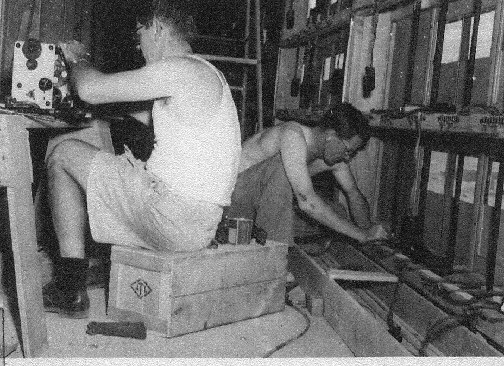
My father William Sydney Johnson (1911-1966) on the left and Fred James on the right (in the image above). Bill is preparing a shutter indicator for installation. It is a small unit, may be used as a horse number or unit of money etc.
The indicator board may have been shipped complete including motors, wiring harnesses, shutter mounting slides, aluminium facia, rubber seals and glass? (Caracas was the same except for lightboxes instead of shutter indicators).
Fred may be attaching the guides for the shutters (in the image below). Above him you can see a shaft with bearings. This shaft had pulleys fitted with stainless steel braid wound on to raise and lower the shutters. This stopped the punters seeing the blinds reset to 999 or 99-1. It also kept the light off the blind material when not in use.
The blind material was treated cambric. Laid out in a long length on a bench at ATL in Chalmers Street, Sydney, it would have a rectangular hole punched out alongside each "odd" (or the expression for 2nd type of displaying money return escapes me). This hole allowed a feeler (like a relay leaf with a centre contact) to change position in bridge circuit to follow the transmitter from the machine room, either the odds or the information from the dividends controller etc.
The box my father is sitting on was typical of the Packing Department's care in transporting totalisators to many places world wide.
Temperature here was 120 degrees F in the shade. Salt tablets and a large amount of water were compulsory every day!
Bill & Fred were accompanied by their families and two years seemed to be a tour of duty in those days.
WSJ outside and Kirk (USA citizen) inside at Las Vegas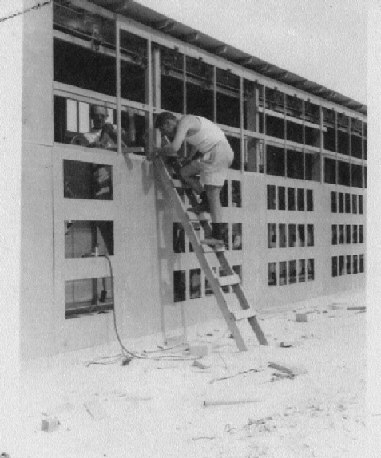
The image above and the second image below show work being performed on the outside of the Las Vegas Indicator building. In these two images and the second image above showing the Las Vegas installation work, dangling cables can be seen terminated in hand sized connectors at the bottom end. The history of these electromechanical totalisator systems long predates the advent of an electronics industry that provided a plethora of different connectors for sale. In these early computing technology years everything had to be custom made including these plugs. The image below shows four of these plugs which were used to connect the electromechanical modules together. In this image the four plugs are plugged into sockets which have been secured to the cable tray.
Some Plastic Moulded ATL connectors
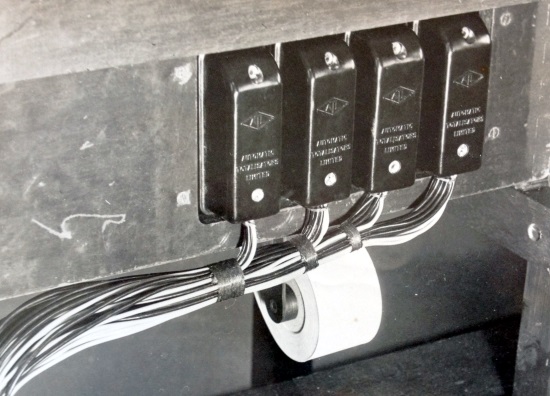
The ATL diamond logo seen on the near end of the box that William Johnson Sr. is sitting on in the third image above, can be made out embossed on each of the connectors in the image above. The words below each of the diamond logos read Automatic on top of Totalisators on top of Limited. The connectors seen dangling in the windows of the near side of the indicator building in the image below, will connect to their respective display modules when they are installed in these windows. This also applies to all the other windows in this building some of which can be seen in the second image above. The other end of these dangling cables will connect to the display driving equipment.
Two William Johnsons at work in the desert Sun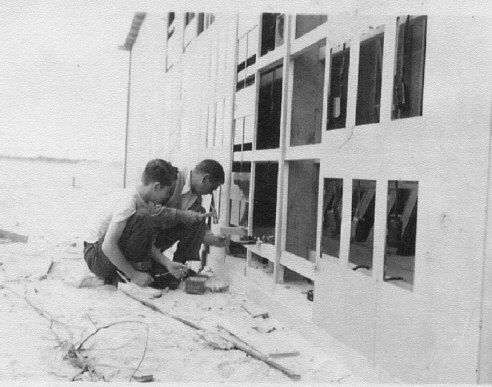
Ten years have passed, it is now 2019 and Bill has provided some ATL documents, a pertinent one of which I have included here. Bill Johnson Jr. mentions above that tours of duty in those days seemed to be two years and installation engineers were accompanied by their families. The company letter shown in the image below was written in 1951 during this tour of duty in North America, away from home in Australia, to Mrs. W. S. Johnson, Bill Johnson Jr.'s mother. It is an example of the process whereby engineers working overseas were accompanied by their families. Mrs. Johnson and her children had a stopover and were staying in what was a palatial hotel in New York City called the Biltimore Hotel. The letter relates ongoing travel arrangements for Mrs. Johnson, Bill Johnson Jr. and his siblings, to fly to Las Vegas to join Bill Johnson Sr. It is interesting to note that the flight took 12 hours in 1951, which may have included a refuelling stop. Today it is about a 5.5 hour flight. Additionally, I don't think travellers today would appreciate a 3AM arrival time, never mind the modern day aviation noise abatement curfew times. Of additional interest is that this letter is written on paper with an ATUSA letterhead. This was the Automatic Totalisators Limited American subsidiary company ATUSA, which is an acronym for Automatic Totalisators USA as mentioned at the top of this page.
A letter to William Johnson Sr's wife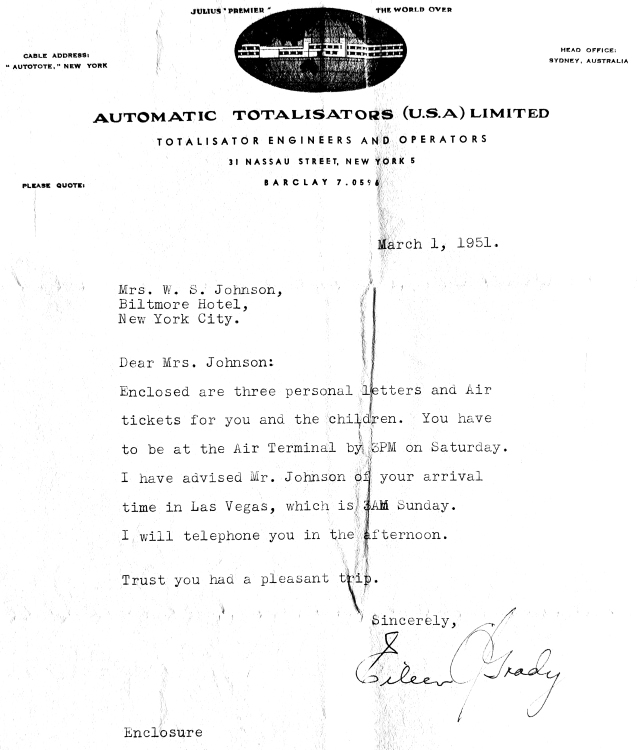
William Johnson Jr. has some recollections of the Caracas installation in the Caracas A Latterday Julius tote installation chapter of this website. To read this, select the Go to the index button in the Nav Bar at the bottom of this page and select the mentioned chapter in the Thirdly section of the index.
As this section relates to Las Vegas and ATUSA I have included a contemporary note here from Joe Brandon in 2015, who used to work for Autotote, which is ATUSA after a name change as mentioned at the top of this page. Note that the CABLE ADDRESS in small text up the top left corner of the letter in the image above, is " AUTOTOTE," NEW YORK already bearing the name Autotote. Following is Joe's note: I'm still in the business. I left Autotote/Sci-Games ten years ago and I'm now running the tote for Las Vegas Dissemination. It's basically the same system I've been working on forever. The company started out as Autotote CBS and then went private. The owner is the son of the owner of a major casino here who actually at one time owned all the Coast properties. Even cooler, I was able to slip right in as we bought the license to 3 systems from Autotote so I'm really at home with it. We also have 4 programmers here who were with the other company to boot.
Joe made the following observation regarding his wife Sue relating to this history: She is part of the history in more ways than one, because she ended up being one of the greats, as to TIM technicians we had at the other company. Worked for them for over twenty years with me and actually worked her way up to running the Tote at Freehold when I took over the Atlantic City hub. She is actually in charge of our Maintenance Department here in Las Vegas now.
| President's Introduction to Autotote Quarterly Spring 1977 |
Autotote Quarterly was an Autotote company magazine. This introduction was extracted from the Spring 1977 copy of Autotote Quarterly and was written by Martin Zwerin President Automatic Totalisators Inc.
During this past quarter, we continued to expand our international activities by establishing Auotote's European headquarters in Konstanz, Germany, under the directorship of Ladislav F. Jaros, an engineer and international businessman with over a decade of totalisator experience.
While the company has been active in Europe for over fifty years, we are now looking at the racing markets there with renewed interest. Europe's complex wagering forms point to possible early application of our sell/cash systems based around our new J22 and J24 sell/cash terminals just recently demonstrated here in the U.S.
In South America we have just finalized a contract with Columbia's Hipodromo de Los Andes. Their PDP-11 based system will utilize our new J17-3 electronic keyboard terminals first installed in the U.S. at Meadowlands.
Here in the United States, growth and planned expansion in the wagering industries give us reason for optimism. The proliferation of horse racing dates, which is now taking its toll on that segment of the pari-mutuel industry, has given rise to increased inter-industry concern and in turn increased cooperation bent on solving the common problems that face all arms of racing.
| A US Patent G.A.Julius & F.A.Wilkinson 1918 |
Following is a US patent US1288910 (A) - 1918-12-24 courtesy of The United States Patent and Trademark Office. On 16 May 2013, I received an email from Richard Irwin. He wrote to me about his grandfather Frederick Augustus Wilkinson who worked on the development of the tote with George Alfred Julius. Richard's brother Murray had informed me about Frederick several years prior. Unfortunately nothing was known about Frederick's association with George and whilst working, I did not have the time to investigate further. It was clear that F.A.Wilkinson appeared on this document as the co-inventor of this Ticket Issuing Machine with G.A.Julius so I presented it here.
In September 2013, I was discarding masses of paperwork in preparation for moving for stage one of retirement. There were a lot of printed documents stored with the intention of reading when time permits. I came across one which caught my attention as it had references to Frederick Wilkinson. The printed pages appeared to be from the era of the mid 1990s when the Internet was dominated by anonymous FTP servers prior to the WWW becoming popular. Consequently the document had no associated web page URL and gave a confused idea of the source and hence the veracity and copyright status of the information. I think the document was created by Rudolph Wilkinson, Frederick's son and quoted newspaper articles and an Encyclopaedia.
The printout indicated George Julius was looking for a TIM (Ticket Issuing Machine) that could be used with new versions of his totalisator and I thought that this was possible at the time George had redesigned the Julius totalisator to be electromechanical and he was considering options for the TIMs. The early Julius Totalisators were purely mechanical and the first, which was installed at Ellerslie New Zealand, had selling stations which were an integral part of the aggregating mainframe. This system had beer tap handle style levers to select the runner number of the transaction. The second Julius totalisator, which too was purely mechanical, was installed in Gloucester Park in Western Australia. It was a significant improvement in that it had separate self contained TIMs, designated J1 terminals. These stood on the ground with no need of a bench and could be used by a standing operator or one seated on a stool. George Julius wrote in a 1932 Gippsland Times newspaper article that this first TIM utilised a complicated series of steel wires. Additionally George wrote the following in that article:
1932 'HOW THE AUTOMATIC TOTALISATOR WAS INVENTED', Gippsland Times (Vic. : 1861 - 1954), 7 January, p. 3. , viewed 20 May 2016, http://nla.gov.au/nla.news-article62691937The complete text of the Gippsland Times article titled HOW THE AUTOMATIC TOTALISATOR WAS INVENTED, can be read in the Mechanical Aids to Calculation chapter of this website. To read this, select the Go to the index button in the Nav Bar at the bottom of this page and select the mentioned chapter in the Firstly section of the index. Finally scroll down to the title How the Automatic Totalisator was invented.I soon discovered, however, that a design restricted to the use of positive mechanism would cripple development, as the machinery was very heavy and all the recording had to be centred at one spot. Attention was then directed to a machine in which electricity would be the connecting medium, but with safeguards to ensure that if there were any failure, the operator would be warned, and the ticket not issued.
I do not know what the Julius Tote chronology of TIM development was after the Gloucester Park system, which started operation in 1916, up till the Julius Tote became electromechanical in 1917. According to my mystery document, it seems George went to the NCR company to see if they could provide a suitable TIM. After receiving a negative reply, Frederick Wilkinson who was a salesman at NCR suggested to George that they could build one together. This was agreed and work commenced on week ends at George Julius' home at Darling Point. The resulting TIM went into production at the Automatic Totalisators factory in Alice Street Newtown.
In February 2017, being retired, I took the time to search the Trove National Library of Australia Internet newspaper archive and discovered that Frederick Wilkinson started as a design engineer later became the State Tote Manager of Automatic Totalisators Limited and worked for the company for 30 years. He is mentioned as the Totalisator Manager of Randwick in some articles and he worked on the Automatic Totalisators Limited installations at Bombay and Longchamps. At the time, Automatic Totalisators Limited had an office at Randwick Racecourse where I presume Frederick spent much of his time.
Rudolph Wilkinson wrote that the machine shown in the patent below was called the Premier Ticket Issuer. As it has been recorded in a company document that the Julius totalisators became electromechanical in 1917, I think the Premier Ticket Issuer could be the first Automatic Totalisators Limited TIM to incorporate electrical elements and hence is an example of the paradigm shift in totalisator design from purely mechanical to electromechanical.
I note that according to the text part of this patent, which starts below after the engineering drawings, George Julius is residing at Culwulla Chambers Castlereagh Street Sydney. This is the head office of George's engineering consulting company Julius Poole And Gibson. The CSIRO was founded in a back office of Julius Poole And Gibson in this building. George did not have far to go to work! I presume the only transportation he required were the high speed lifts that his company Julius Poole And Gibson had installed at Culwulla Chambers.
 Go back to the index
Go back to the index  Go to the bottom of the page
Go to the bottom of the page
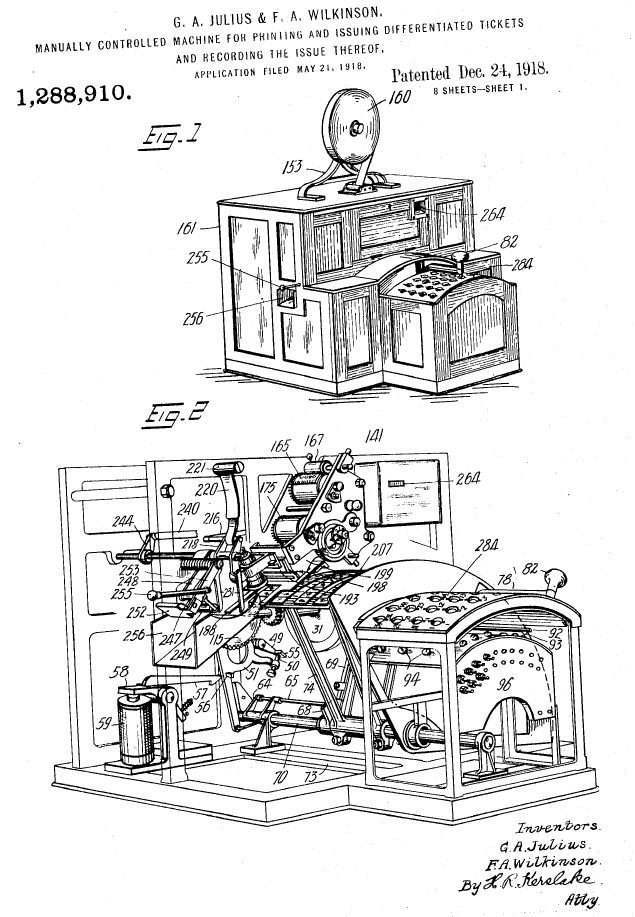
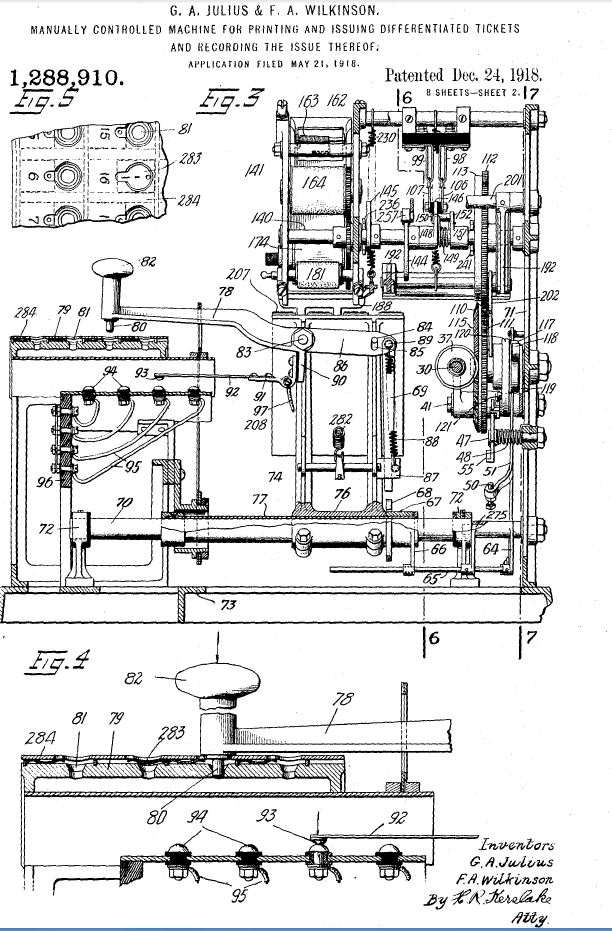
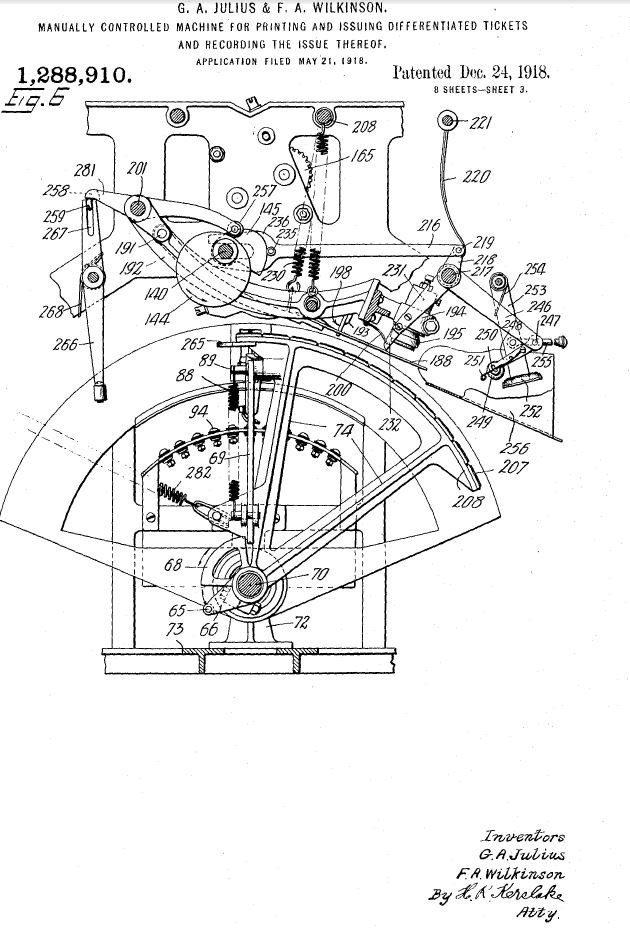
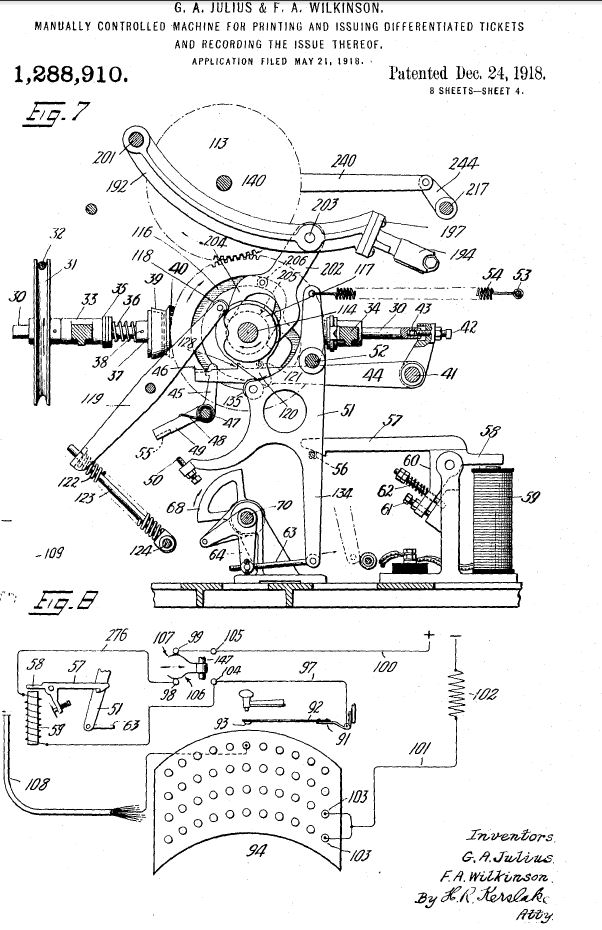
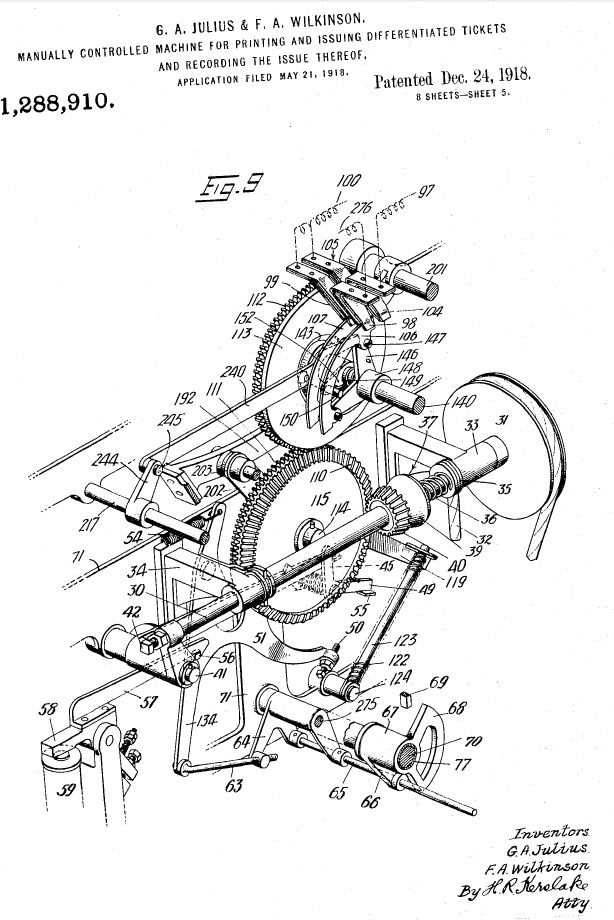
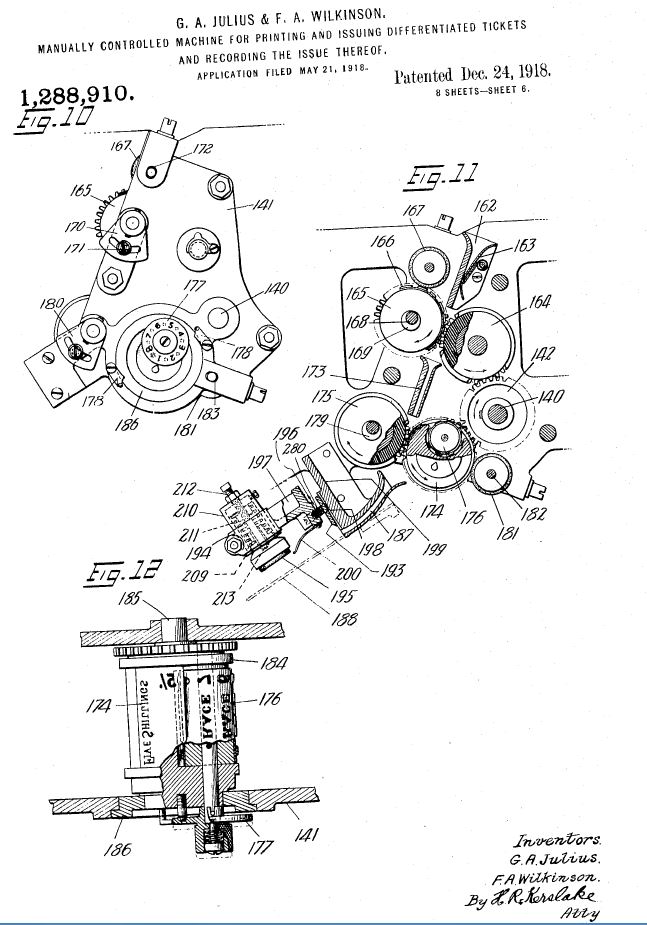
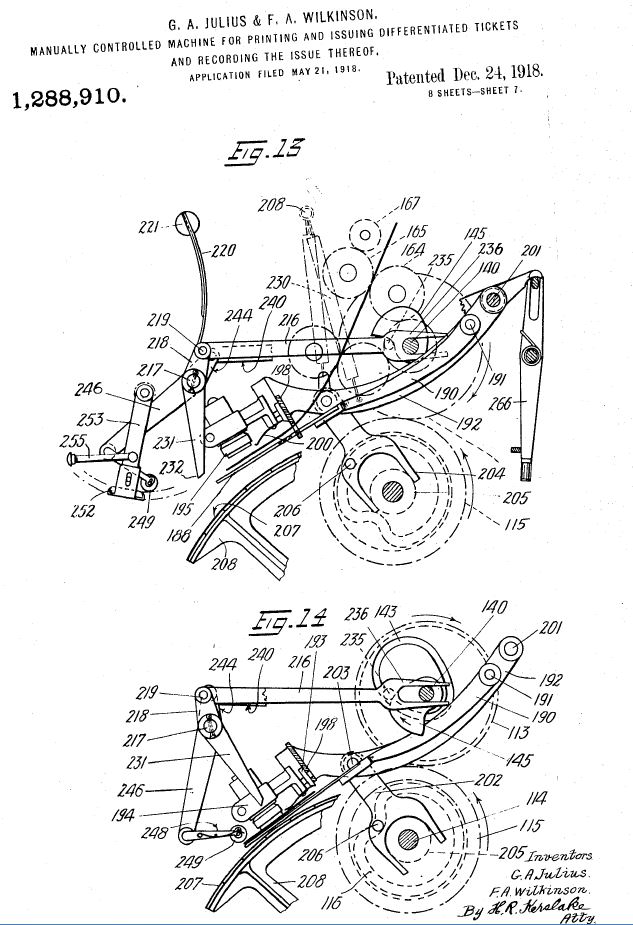
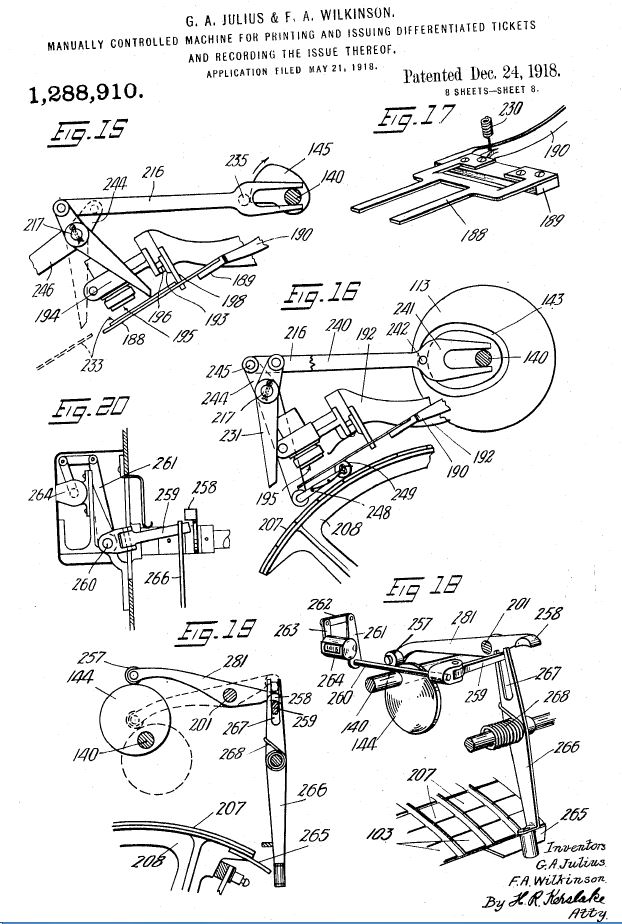
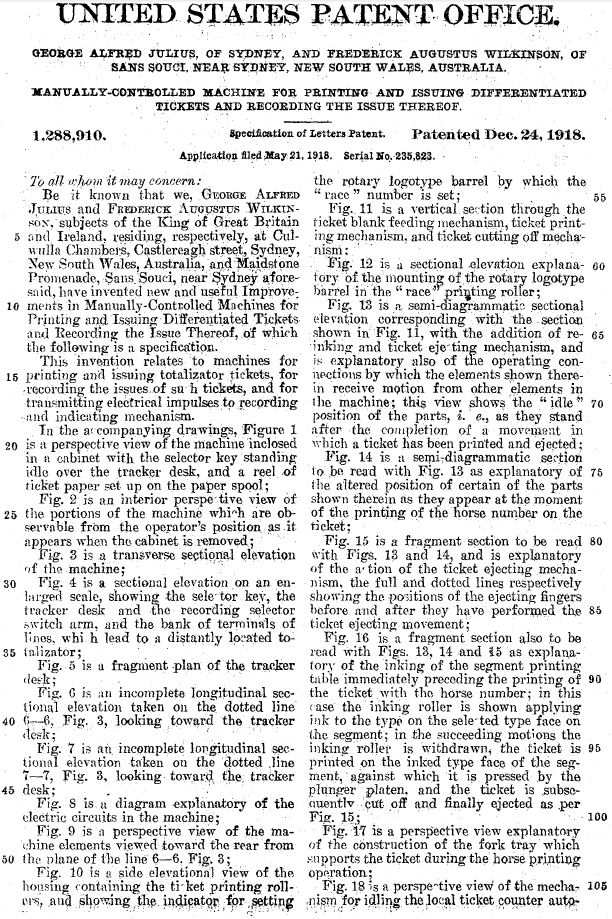
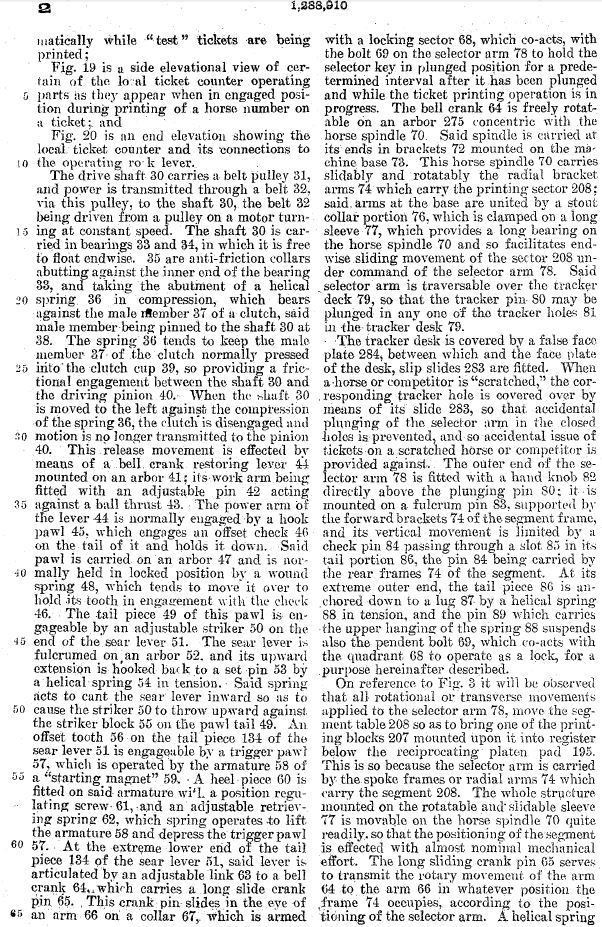
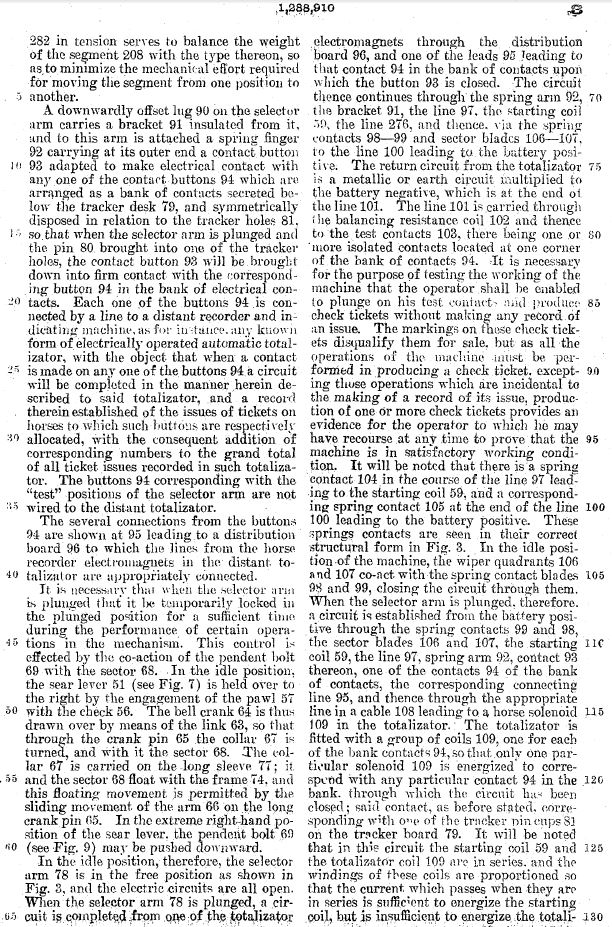
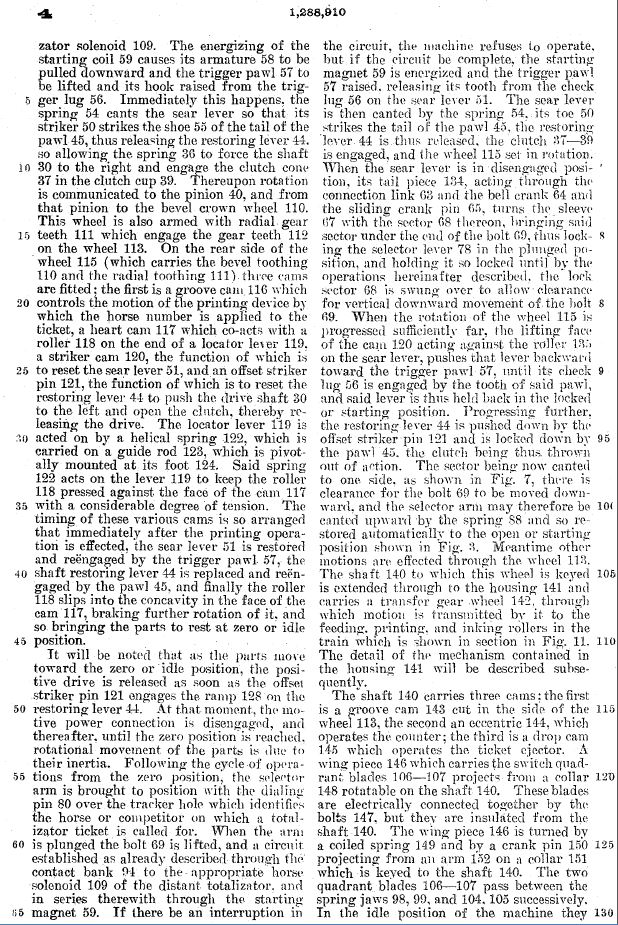
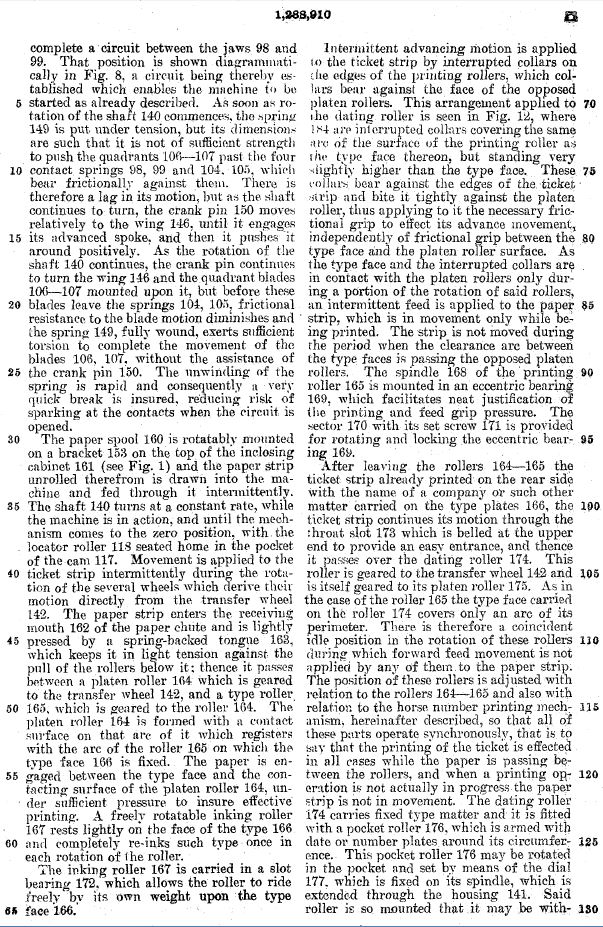
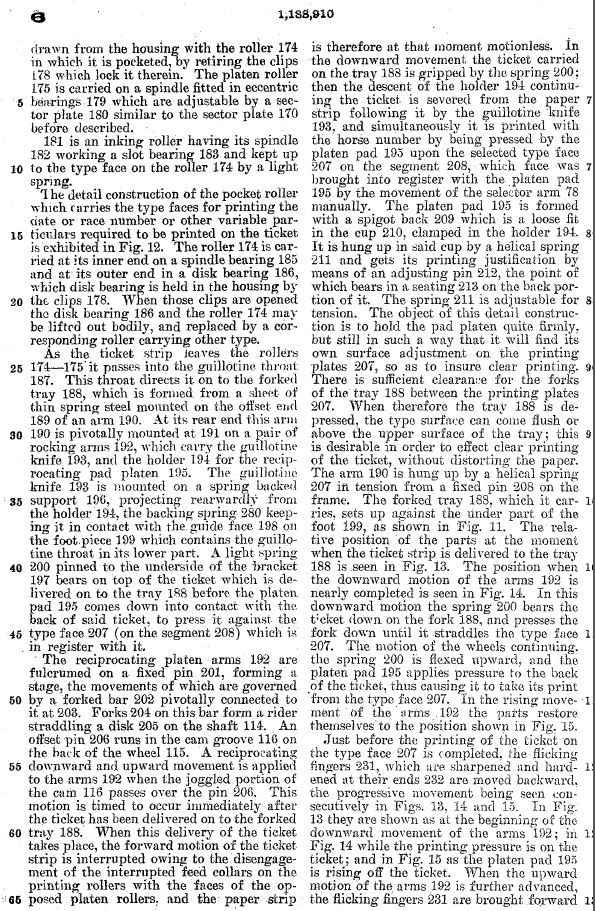
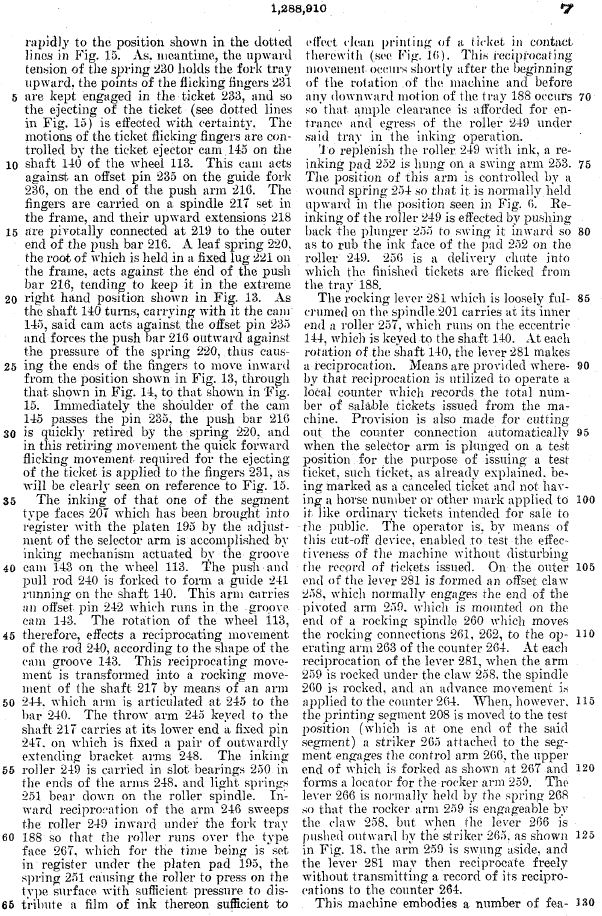
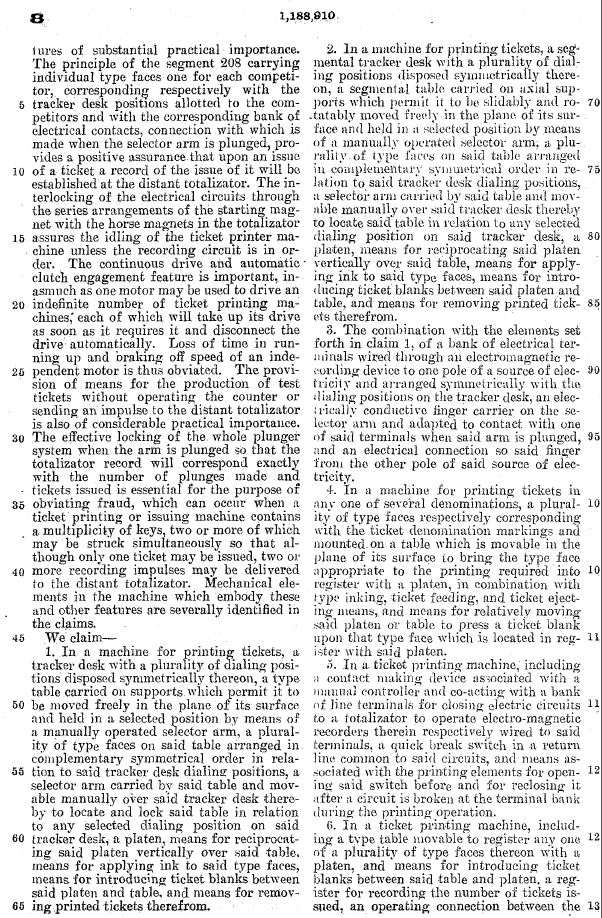
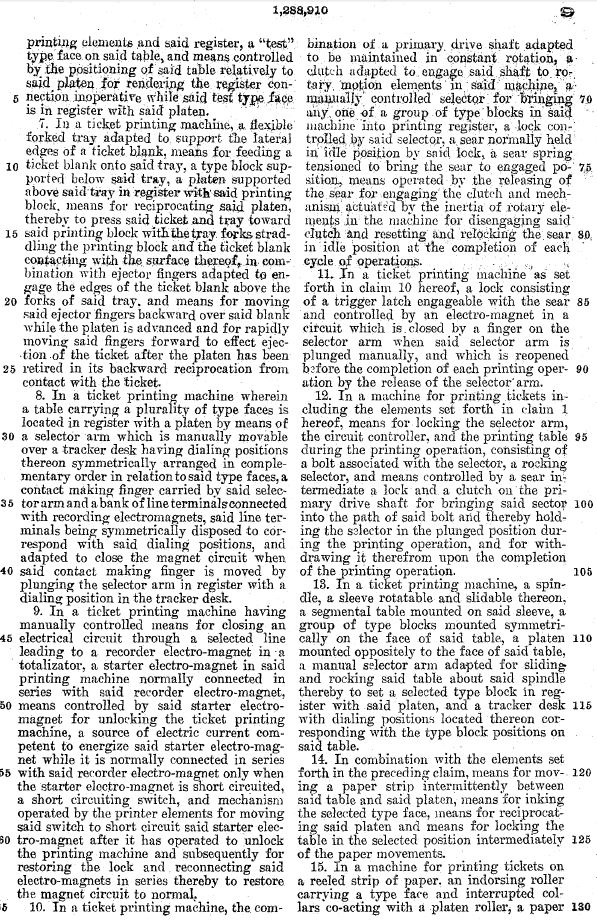
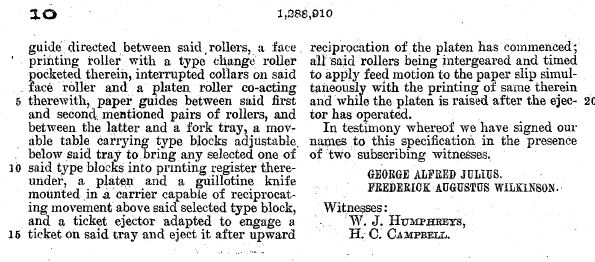
![]()
| Acknowledgements |
Comments and suggestions welcome to
totehis@hotmail.com
| Previous page | Go to the index | Top of the page | Next page |